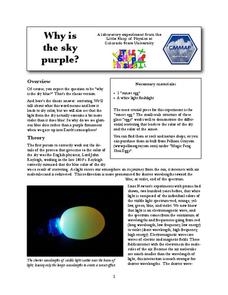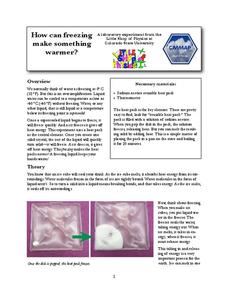Curated OER
Summary of Shapes of Molecules
Neatly organized and easy to read, this chart summarizes five different molecular shapes: linear, trigonal planar, tetrahedral, trigonal bipyramidal, and octahedral. It associates shapes with electron pairs and atom arrangement and lists...
Royal Society of Chemistry
Organic Molecules Day—Chemistry Outreach
In search of an organic lab that employs real-life techniques and analysis methods? Groups carry out the nitration of methyl benzoate, then attempt to determine the number and location of the nitro groups added to the benzene ring....
LABScI
DNA Structure: Gumdrop Modeling
DNA molecules hold the secrets that make us unique. The fourth of 12 lessons explores the structure of DNA by building candy models. After building the models, young scientists break their models to begin the process of DNA replication....
Creative Chemistry
Working out the Shapes of Molecules
For this molecular geometry worksheet, learners are given directions and four examples for predicting the geometry of molecules. They determine whether the molecules are pyramidal or trigonal bipyramidal.
American Chemical Society
Aware of the Air
It's there, even though no one can see it. Scholars create two different-sized parachutes out of shopping bags, then let them fall through the air. They should see that the larger parachute falls more slowly and interpret this to mean...
American Chemical Society
Heat - Energy on the Move
Turn up the heat. Individuals conduct two experiments to observe the difference between heated water and air versus cold water and air. Using food coloring, pupils observe the movement of the molecules in the two temperatures of water. A...
Creative Chemistry
Energy Changes in Reactions
For this chemical bonds learning exercise, learners determine how much energy is needed to break bonds. Students classify reactions as exothermic or endothermic and identify a reaction as reversible. This learning exercise has four...
University of Georgia
What's So Special about Bottled Drinking Water?
Is artesian water designed to be better, or is it just from wells similar to those in the city of Artesium? This experiment looks at many different types of bottled waters, including artesian. Using a soap mixture, scholars test to see...
American Chemical Society
Diapers: The Inside Story
There shouldn't be any accidents with this activity! An inquiry-based lesson has learners explore the absorption properties of the gel compound in diapers. After testing its properties, they learn the science of the molecules that make...
NASA
The Case of the Wacky Water Cycle
Join the tree house detectives in learning about the processes of the water cycle, water conservation, water treatment, and water as a limited resource.
American Chemical Society
Fizz Bizz
Bubbles seem to come from nowhere. Pupils investigate the formation of carbon dioxide bubbles in sodas. By placing different objects, including candies, in the soda, learners observe the formation of tiny bubbles on the surface of the...
American Chemical Society
Time for Slime
Slime is more than just a fun pastime. Learners study the bonding of polymers using a mixture of glue, borax, and water. They then explore the properties of the slime and learn how the polymers in glue bond with ions in borax.
American Chemical Society
A Closer Look at Crystals
It's about to become crystal clear! Learners compare and contrast three different types of crystal substances. First they observe their structure and then investigate how they interact with various substances.
Creative Chemistry
Hydrocarbons and Fractionation
For this compounds worksheet, students identify molecules as compounds and provide a reason why they believe it is or is not a compound. Students write out chemical formulas. This worksheet has three problems to solve.
Colorado State University
If Hot Air Rises, Why Is it Cold in the Mountains?
Investigate the relationship between temperature and pressure. Learners change the pressure of a sample of air and monitor its temperature. They learn that as air decreases its pressure, its thermal energy converts to kinetic energy.
Nuffield Foundation
Microscale Investigations of Catalase Activity in Plant Extracts
Use indirect measurements to monitor metabolic activity in plant cells. Scholars understand that cells with a higher metabolic rate have a higher concentration of catalase enzyme. They use this information to compare metabolic rates of...
Nuffield Foundation
Investigating the Effect of Temperature on the Activity of Lipase
How does temperature affect lipase activity? Young scholars conduct an experiment to collect data on the interaction of lipase at different temperatures. They add lipase to a solution of milk, sodium carbonate, and phenolphthalein and...
American Chemical Society
The Energy of Evaporation
Do all liquids evaporate at the same rate? Young scientists observe the evaporation rate of three different liquids. They measure the time, the temperature, and the change in energy. After comparing the chemical formulas, scholars...
Serendip
A Scientific Investigation – What Types of Food Contain Starch and Protein?
You are what you eat, as they say! Are you more starch or more protein? Young scholars use their knowledge of each component to test different foods for their content. Using multiple indicators, individuals describe the protein and...
Colorado State University
Why Is the Sky Purple?
The color of the sky depends on the time of day. Young scholars experiment with scattering different wavelengths of light to recreate the color of the sky. They observe both the longer blue wavelengths and the shorter red and orange...
Colorado State University
Can Gravity Push Something Up?
How does a hot air balloon fly? An experimental lesson has scholars build a balloon from a garbage bag and monitor the movement of air. As the temperature of the air in the balloon increases, gravity moves the denser cool air down,...
Colorado State University
How Can Freezing Make Something Warmer?
Crazy fact—freezing liquid actually gives off heat! Young scholars investigate the transfer of energy when liquids freeze using a chemical heat pack. The heat pack gives off heat as its liquid core freezes.
Creative Chemistry
Maths for AS Chemistry
No practice problems are given on this handout; it is a detailed list of concepts to know and tips for working related problems in chemistry. Give this to learners as a study guide, or use it early in your career as a chemistry...
LABScI
Acoustics: The Sound Lab
If the delay between a sound and its echo is less than 1/10th of a second, the human ear can’t distinguish it. Through the use of a Slinky, rubber band guitar, and straws, scholars explore where sound comes from and how it travels....
Other popular searches
- Atoms and Molecules
- Gumdrop Atoms and Molecules
- Atoms & Molecules
- Compounds and Molecules
- Water Molecules
- Organic Molecules
- Atoms Molecules
- Building Molecules
- Molecules of Life
- Gas Molecules
- Matter and Molecules
- Biological Molecules























